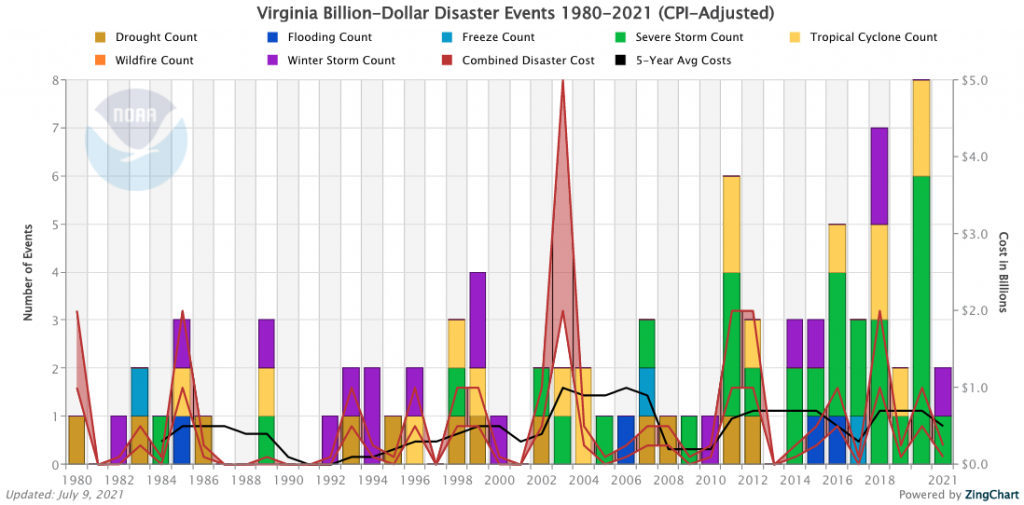by Ellen Szymanski and Annette Osso, Resilient Virginia
Investing in projects and initiatives in four critical sectors — transportation, buildings, energy, and water — are key to both working on mitigation strategies and building resilience as communities face increased challenges from sea level rise, extreme storm events, and rising temperatures. The Intergovernmental Panel on Climate Change (IPCC) 6th Assessment on Climate Change is “unequivocal that human influence” has caused climate change. It is also true that humans can solve the climate crisis. Over the last several years, Virginians have shown that they can take policy and program steps that position the state at the forefront of addressing these challenges.
The need to address greenhouse gas (GHG) mitigation and to build resilience into existing infrastructure and new projects is well documented in the context of natural disasters and climate change impact. A 2020 report from the Virginia Academy of Science, Engineering and Medicine points out the “increasingly disruptive effect” on residents of Virginia’s coastal areas from climate impacts. It also concludes that the state needs to develop a statewide resiliency plan.
Virginia’s severe storm events and overall costs have grown as seem in the table below on billion-dollar disaster events that are tracked NOAA by state since 1980. View the tool at https://www.ncdc.noaa.gov/.
The 2021 Resilient Virginia Conference track on infrastructure adaptation will look at progress in the transportation sector, buildings and energy, and water infrastructure sectors.
Virginia Transportation Policies and Programs
The Virginia Transportation Policies and Programs session speakers will discuss progress being made in legislation, programs, and on-the-ground projects that include expanding vehicle electrification and addressing the challenge of equitable access to sustainable and resilient transportation systems.
August 25 | 10:10–11:30 AM
Angela Conroy, Air and Renewable Energy Planner, VA DEQ
Alleyn Harned, Executive Director, Virginia Clean Cities
Jeremy Holmes, Executive Director, Roanoke Valley-Alleghany Regional Commission
Moderator: Blair St. Ledger-Olson, Program Manager, Generation180
Resilient Buildings and Energy Systems
The Resilient Buildings and Energy Systems session will review the massive leap forward in clean energy policy that we have seen in Virginia in the last few years, will look at the state of microgrid development, and will outline resilient building design guidelines and using innovative financing to move energy efficiency and renewable improvements forward.
August 26 | 10:10–11:30am
Speakers
Rich Sweetser, President, Exergy Partners Corp
Abby Johnson, Executive Director, Virginia PACE Authority
Kara Strong, Project Director, Sustainable Design Consulting
Moderator: Chris Stone, P.E., Senior Principal, Resilience Design, Clark Nelson
Living with Water: Systems and Management
The Living with Water: Systems and Management session looks at state policies to address flooding and sea level rise, and will include examples of how regional governments and cities are putting adaptation plans and projects in place. An additional presentation will look at the process of risk management analysis for water authorities.
August 26 | 11:40am–1:00pm
Speakers
Speaker Pollard, Partner, Williams Mullen
Don Cole, Vice President, Brown & Caldwell
Scott Smith, Senior Civil Engineer, City of Hampton Public Works
Linda Warren, P.E., CEO and Project Principal, Launch Consulting
Speaker & Moderator: Denise Nelson, P.E., Consultant
Transportation
Transportation is the largest source of greenhouse gas (GHG) emissions in the United States, currently standing at 29% of our total emissions — half of which comes from passenger cars and light trucks. The other half of GHG emissions is caused by commercial transport — airplanes, ships, boats, trains, and pipelines. Moving to lower-emissions fuel, electrifying transportation, using clean energy sources, and promoting public transit will go a long way toward mitigating climate change.
The U.S. is currently the third-largest electric vehicle (EV) market in the world — and growing. Ninety percent of U.S. states provide incentives for hybrid and electric vehicles. Earlier this year, Virginia passed a package of bills to support electrification of its transportation sector. The Clean Car Standards (HB1965) will require car manufacturers to increase EV inventory; HJ542 will provide for a study on transit equity; and HB2282 requires delivery of a set of recommendations to speed up state-wide adoption of EVs by May 2022. An EV rebate policy (HB1979) and a grant for electrifying school buses (HB2118) passed but remain unfunded.
Buildings and Energy
Electricity production generates the second largest share of greenhouse gas emissions (25%), with approximately 62% of our electricity comes from burning fossil fuels, mostly coal and natural gas. Commercial and residential buildings generate 13% of greenhouse gases. However, because buildings use 76% of electricity output, when GHG is calculated by distributed end use, buildings account for 31% of emissions. (USEPA)
The 2018 Virginia Energy Plan, published in 2018 by the Department of Mines, Minerals and Energy (DMME), established four key areas to transition Virginia to a new clean energy economy. The goals include:
- Diversify Virginia’s economy by strategically growing the energy sector.
- Innovate to reduce greenhouse gas emissions and lower energy consumption throughout the Commonwealth.
- Strengthen Virginia’s business climate by investing in reliable and resilient energy infrastructure.
- Prepare Virginia’s workforce to drive the energy economy into the future.
These goals have been moved forward over the past several years by significant clean energy legislation that was enacted by the General Assembly with support from Governor Ralph Northam’s office. Two major accomplishments were the passage of the Clean Economy Act, which put in place a mandate to move to 100% clean electricity generation by 2050, and the passage of legislation allowing Virginia to be the first Southern state to join the Regional Greenhouse Gas Initiative (RGGI). This market-based collaborative effort among Northeast and Mid-Atlantic states is designed to combat climate change and reduce greenhouse gas emissions from the power sector, while driving economic growth. In January 2021 the Virginia Department of Mines, Minerals and Energy (DMME) launched a new information center to track the progress towards a Clean Energy Virginia. The Dashboard will detail, in various categories, transparent progress toward meeting the goals of the Virginia Clean Economy Act.
In the building sector, public and private initiatives have moved Virginia slowly toward higher energy efficiency and clean energy goals. In March, 2021, Governor Northam signed into law a bill that both expanded the older High Performance Buildings Act for state government facilities and added green building requirements for Virginia localities. Beginning July 2021, localities of 100,000 or more residents must meet several building project criteria, including LEED or Green Globes third-party certification or compliance with Virginia’s adaptation of the International Green Construction Code. Smaller localities have until July 2023 to comply.
To increase building flood resiliency, Governor Northam issued Executive Order Forty-Five in 2019 which creates the Virginia Flood Risk Management Standard to improve flood protection in flood prone areas across the state, further encouraging smart and resilient construction of state buildings. A first of its kind for any state, the standard requires that state-owned buildings are built to certain elevation standards to protect them from flooding. The new standards applies to all state-owned buildings authorized for construction after January 1, 2021.
Water Systems
As documented in Virginia’s Coastal Resilience Plan, Virginia has already seen higher rates of sea level rise (18 inches) than the global average (8 inches) due to land subsidence, landfilling from development, and other geological changes. Regional inundated modeling studies have looked at what areas in the coastal region will flood due to rising tides.
The Virginia Academy of Sciences, Engineering and Medicine recent study shows that relative sea levels could rise by 6.69 feet between 2000 and 2100 in Norfolk, and that Norfolk’s stormwater infrastructure has lost 50% of its designed capacity due to rising sea levels. In Hampton Roads, flood damage from a 100-year storm — that is, a storm with a one percent chance of occurring in any given year — would cause the regional economy to shrink by $611 million the following year.
As outlined in Denise Nelson’s article in the June 2021 The Reporter, the monthly journal of the American Public Works Association, Virginia has the “most forward-looking standards in the nation to account for the impacts of sea level rise and more frequent and intense rainfall events.”
Virginia is coordinating federal and state funds to develop guidelines and priorities for state and local projects to address flooding and sea level rise. In 2018 Governor Northam signed Executive Order 24, Increasing Virginia’s Resilience to Sea Level Rise and Natural Hazards, which put into effect work on a Coastal Resilience Master Plan, due out before the end of 2021. In 2020 Virginia’s General Assembly created the Virginia Community Flood Preparedness Fund, which is being managed by the VA Department of Conservation and Recreation. This program provides grants and loans to communities across the state to plan and carry out flood mitigation projects. You can find out more about local initiatives in the APWA article.





